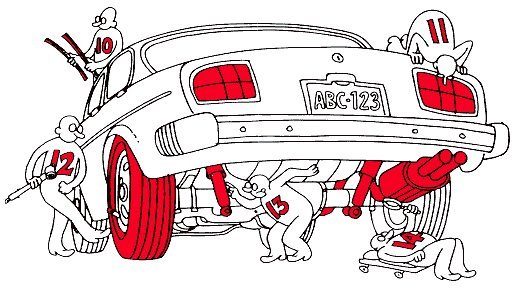Mechanical Tips.
All mechanical work on a vehicle meets certain safety. Here are some precautions not to be overlooked: Often, maintenance and repair of a vehicle require working on a raised vehicle. We do not necessarily need a lift, but simply candles, since the work is done on the ground.
Work (brakes, steering, suspension, etc..) On a raised vehicle often consist of removing one or more wheels.
When opening a cover, it is imperative to disconnect the negative battery terminal. If this is the positive terminal is disconnected, there may be a short circuit due to contact with the key on the body (ground). Normally, this measure only applies to electrical and electronic organ replacement, but a short circuit can occur at any time. For example, if a metal object (screwdriver, keys, etc.). Escapes your hand and falls in the engine compartment, it may cause a short circuit and thus a fire.
As a vehicle contains several types of flammable materials (gasoline, oil) and there are also risks of a fire-related electrical components, it is necessary to have a fire extinguisher in working order at hand.
The maintenance of a car should not be done without the proper protective equipment: latex gloves (see contact with corrosive liquids and the precision work) or leather (for the work structure), shoes safety glasses and masks, as required.
Multiplexing
Nowadays, more and more vehicles are equipped with the system multiplex '. Multiplexing is a technique passed several pieces of information through a single transmission medium. And the same information is transmitted to several electrical and electronic organs (lock, wipe, power window, projector, active and passive safety, motor management ...) of the vehicle.
For these reasons, after cutting the contact, must be respected a time of put into standby multiple calculators. It is wise to wait several minutes before disconnecting the battery.
Technical Control (fitness)
The technical control is in other words a certificate of compliance which determines whether the car is in good condition. All vehicles less than 3.5 tonnes are concerned except two-wheelers. The technical inspection is performed by a state-approved organization.
Technical inspection, mandatory, was established to prevent accidents due to cars that are old and in poor condition. It has continued to evolve and become more picky with time.
When the owner sells the car to someone, it is required to provide the purchaser with a report of a technical inspection (certificate of fitness obtained within the time limit). Otherwise, the new owner can not put it on the road.
Meet the deadline
Every owner of a motor vehicle is required to ensure that it has the certificate of fitness with him when he takes the road. If it is a new car, the owner will have to perform the following check within seven years. If it is a reconditioned car, say three years, the owner will deduct three years and will be the next audit within four years. After that, the control becomes periodic and is conducted every two years.
Sanction
If the timing is not met, the vehicle owner is liable to a fine. However, this has nothing to do with penalty points.
Prepare technical control
In Europe, France, for example, there are approximately 130 control points (depending on the vehicle) into 10 categories. You can check yourself some point before placing your technical control. They are:
- Vehicle Identification
- Braking
- Check the level of brake fluid and brake fluid warning
- Management
- Visibility
- Check that the ice of your mirrors are not damaged and that the fasteners are regulatory
- Verify proper operation and wear of your wiper blades
- Check that the washer is working properly
- Lighting, signage
- Check the operation of traffic lights and turn signals on your vehicle: front turn, back and side; distress lights, parking lights, brake lights, headlights, high beam, the illumination of rear plate
- Ground connections
- Structure, body
- Verify proper operation of the opening and closing of doors, trunk, hood
- Equipment
- Check belts, horn, seat fixations
- Mechanical components
- Pollution, noise
- Check the engine oil level, and the level of the cooling liquid
- Check exhaust system does not leak.
Related News



